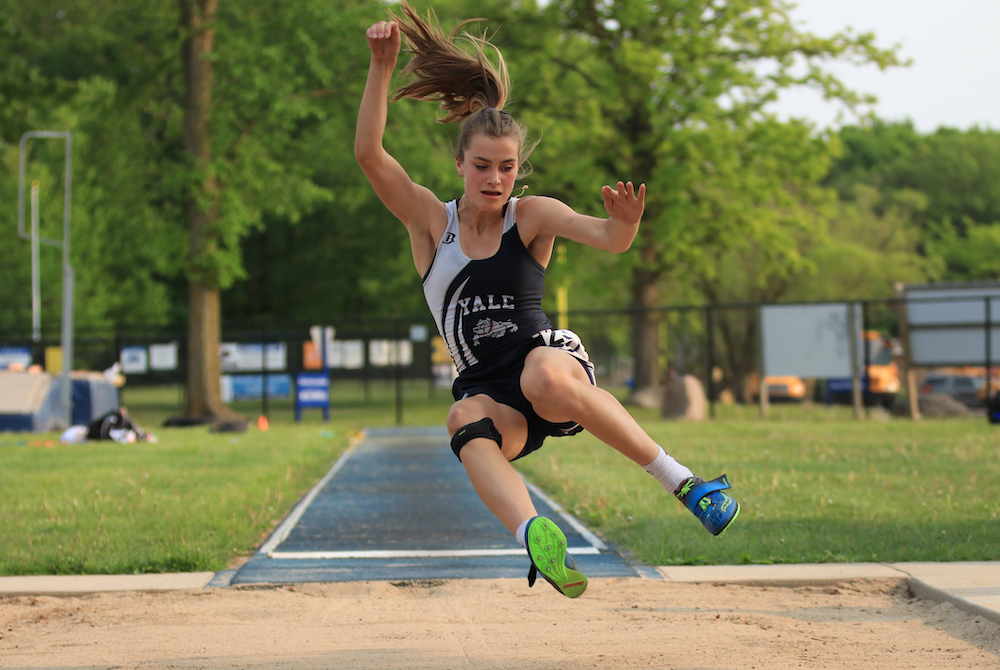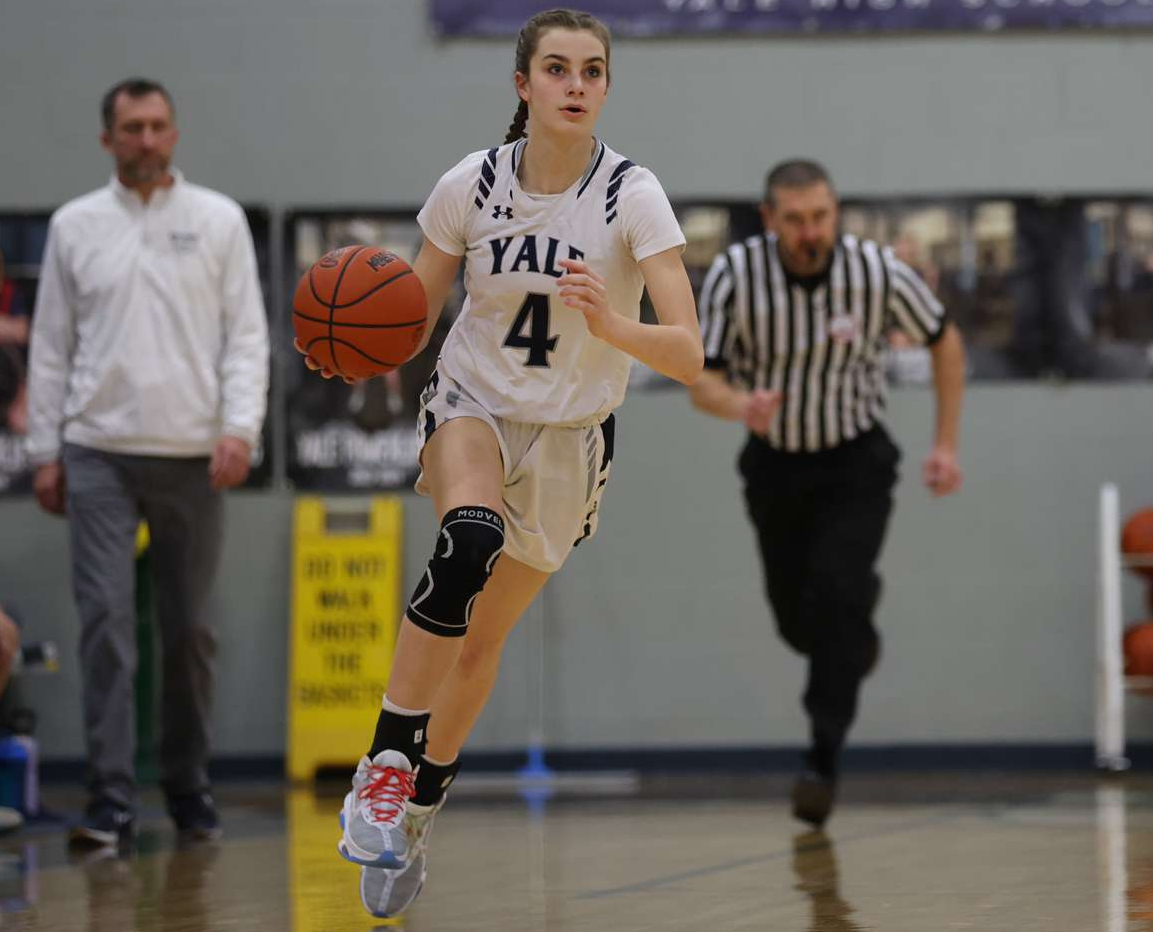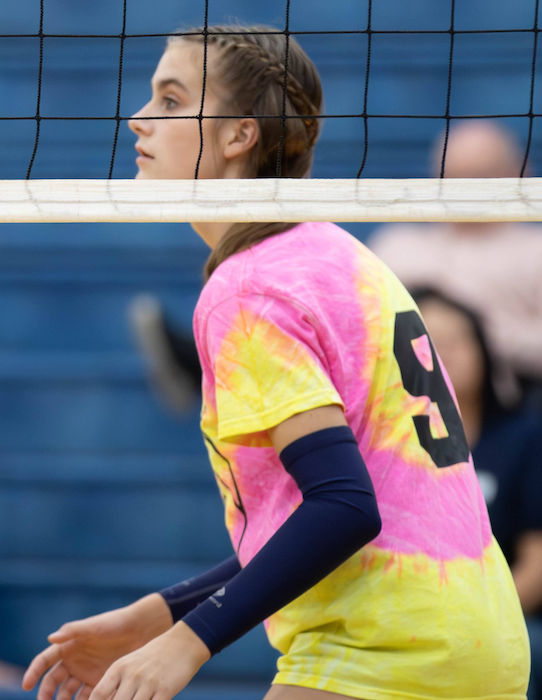
Track Gaining Speed Toward Future with Electronic Starting Devices
By
Steve Vedder
Special for MHSAA.com
May 23, 2023
Aubrey Greenfield thinks it might be the perfect time to reevaluate 130 years of tradition.
For a number of reasons, from technical to personal, the Oxford senior sprinter believes it makes sense for the crack of a starting pistol to be eliminated from high school track meets.
Because track meets would benefit in various ways from lowering costs to easier setup at meets to the human factor of competitors not having to flinch at the crack of a pistol shot, Greenfield believes the sport has a chance to embrace new technology – electronic starting devices (ESD).
In essence, an ESD replaces the starting pistol with a light flash, tone sound or both to begin a race.
"High school sports should put the athlete first," Greenfield said. "We should promote sports, and eliminating starting pistols promotes health in terms of PTSD or trauma for athletes and spectators and that would be good. I would like to think people would say that's a good idea."
In fact, Greenfield would go as far as to say if there was not an implementation of electronic starting devices, many of her teammates would have considered giving up the sport.
"If it's something that helps us compete safely, we're all for it," she said.
Greenfield's opinion apparently is spreading. Michigan High School Athletic Association senior assistant director Cody Inglis said the use of ESD makes it both affordable for meet starters and sensible for athletes and fans to rethink the use of starting pistols. While the MHSAA is not mandating electronic starting devices, it does promote the use of what Inglis calls "emerging technology." He notes that ESD are becoming the norm for organizations such as USA Track & Field, the NCAA and an increasing number of high schools.
 "I think we have to embrace new technology, and we think this will be something that takes hold," Inglis said.
"I think we have to embrace new technology, and we think this will be something that takes hold," Inglis said.
A key part of embracing ESD is the human element. The tragic Oxford High School shooting Nov. 30, 2021, that took the lives of four students while injuring seven others should not be relived even for a fleeting instance at a high school sporting event. Oxford athletic director Tony DeMare said the school began using ESD at every meet, including the MHSAA Lower Peninsula Division 1 Finals last June. He said that decision was embraced by virtually all schools Oxford encountered.
"We were very convinced that the alternative (of ESD) would promote a healthy attitude," DeMare said. "We were overwhelmed with the positive response. If a school was on the fence about it or might not be for it, I think we've started to see the tide turn in favor of people willing to listen and learn about electronic starting devices."
Inglis said the MHSAA is acutely aware of what the crack of a starting pistol can mean to athletes and fans.
"It's unimaginable what Oxford went through, and this is a small way we can help," he said. "We look at a (starting pistol) and think, ‘Could we do something else?’ It's a way of helping to solve a problem."
Over the last several years, the MHSAA has embraced finding an alternative to starting pistols. Inglis noted the discussion started with the cost and diminishing availability of 32-caliber ammunition that meet starters use. A box of ammunition, if it can be found, is around $75 a box.
In addition to cost, there is potential damage from excessive exposure to 150-plus decibels of sound generated by the traditional 32-caliber blanks. Medical studies show damage to ears caused by decibel levels above 120 dB.
The tragedy at Oxford accelerated the conversation.
Inglis said the cost of ESD can be likened to a school sinking money into artificial surfaces at football fields. Yes, there is a great cost at first, but over time money is ultimately saved. An ESD system itself ranges between $200 and $500. Speakers also may need to be purchased, but with ESD starting events like the 800 and 1,600-meter relays positioned near the outside lanes 8, 7, 6 and 5 would result in improved hearing by athletes at the start of a race.
There is one challenge with ESD that track administrators are working to overcome – lighting conditions that lessen the ability to see the ESD’s LED light or strobe when the button is pressed by a starter to begin a race. But that vision difficulty resulting from clear blue skies and backgrounds of setting suns can be substantially improved by incorporating a black background with an ESD – something as simple as a starter holding up black cardboard behind the lighting mechanism at the start of an event.
Inglis said when all factors are considered, the use of ESD makes sense.
 "With the climate we live in nowadays, no lookalike guns is good," he said. "We're not mandating this. But people are saying this is affordable."
"With the climate we live in nowadays, no lookalike guns is good," he said. "We're not mandating this. But people are saying this is affordable."
While switching to ESD would break 130 years of tradition, the timing could be a step forward, said Jeff Hollobaugh, co-author of the book "The Fleet Feet of Spring: Michigan's High School State Championships in Track & Field." He said while no definitive answer is possible, it's likely starting pistols were used at the inaugural state meet at the Jackson Fairgounds in 1895. The meet, which included events like tossing a 16-pound shot put, bike races and a 100-meter sprint, was sponsored by the Michigan Interscholastic Athletic Association (a predecessor to the MHSAA) and comprised mostly of the state's larger schools.
Hollobaugh's sentiments echo what many involved in today's high school track & field believe in terms of making a transition from starting pistols to electronic starting devices.
"It's a change, not necessarily good or bad, just different," he said. "It's not a drastic change, but it will take some getting used to. But it is the future. In the end, we'll all be fine."
DeMare believes the future of high school track will definitely include ESD.
"Our desire is that the practicality and sensibility of this will overcome the alternative," he said. "I think we'll see the automation and electronics taking hold of certain elements in track, and people will embrace it."
PHOTOS (Top) Runners watch official Bertha Smiley as they prepare to begin a race during last season's Lower Peninsula Division 1 Finals at Rockford. (Middle) An electronic starting device provided by VS Athletics was used to start those races. (Below) Smiley sets to begin an event. (Photos provided by David Kuderka/VS Athletics.)

Yale's Dykstra Wasting No Time Showing Superior Multi-Sport Potential
By
Paul Costanzo
Special for MHSAA.com
March 28, 2024
Sadie Dykstra’s already long list of accomplishments from less than two years of high school – three all-state medals, multiple all-conference awards and a league MVP to name a few – may seem shocking.
 And to most, it justifiably is.
And to most, it justifiably is.
But it’s come as little surprise for those in Yale who saw her grow up and do, well, anything.
“I’ve always known that she’s kind of special,” said Yale boys track coach and Dykstra family friend Brian Bearss. “She was that kid that, when other kids would be playing and learning how to ride their bikes, here comes Sadie and she’s yelling, ‘Look at this,’ and standing on the seat riding the bike. She’s always been exceptional as far as being an athlete.”
Dykstra is entering her sophomore track & field season at Yale and has already established herself as one of the best female athletes in the state. Want to argue against that? Check out this résumé:
Volleyball: Two years varsity, second-team all-Blue Water Area Conference as a sophomore.
Basketball: Two-time first-team all-BWAC selection, BWAC all-defense and BWAC MVP as a sophomore, BCAM all-state honorable mention as a freshman, sophomore all-state honors still pending.
Track: Unbeaten in the BWAC as a freshman with four league titles (long jump, 100 hurdles, 300 hurdles and 1,600 meter relay), three all-state finishes at 2023 Lower Peninsula Division 2 Finals (fourth in long jump, fifth in 100 hurdles, sixth in 300 hurdles).
Again, just a sophomore.
“I can’t believe that I get to coach her,” Yale girls track coach Ashley Garofalo said. “She has a drive and a mindset that I can’t teach somebody. Nobody can teach you to have this. She gives every single thing that she has in every single sport. I think it does help when you’re so good at it. It makes you want to do it more.”
 Basketball gets Dykstra’s most attention and it’s the one she’d most like to play at the next level. The 5-foot-11 guard is getting interest already from Division I college programs.
Basketball gets Dykstra’s most attention and it’s the one she’d most like to play at the next level. The 5-foot-11 guard is getting interest already from Division I college programs.
But it wouldn’t be right to say her heart is with one sport or another.
“I enjoy all my sports,” Dykstra said. “I like all my teams. I have a different team for each one, and I get along with all those girls. I think each one, it flows into the next one, and helps strengthen things for my other sports. Volleyball helps my legs for basketball. In basketball, I’m getting in shape for track.”
You don’t have to look far to find where Dykstra gained her love for athletics. Her parents, Kerry and Brad, both played basketball at Calvin College. Kerry graduated as Calvin’s all-time leading scorer in 1999 and is still sixth on the all-time list. She also served as Yale volleyball coach for 10 years, just recently stepping down.
Brad was a two-sport athlete at Calvin, playing baseball as well. He also played baseball at Grand Valley State. He coached basketball at Yale from 2006-10.
“We’re a very sporty family,” Sadie Dykstra said.
So, when it came time to enter high school, there was never a thought of specializing.
“I came in with the mindset of, I’m going to play three sports each season and enjoy them, too,” Dykstra said. “I don’t want to be in them and have them be the most awful things in the universe. I came in with the mindset of enjoying all three sports.”
 While basketball is her current collegiate goal, she did say that competing in basketball and track & field would be something she would consider if given the opportunity. Bearss said Dykstra has Division I potential in track & field, adding that heptathlon could best suit her.
While basketball is her current collegiate goal, she did say that competing in basketball and track & field would be something she would consider if given the opportunity. Bearss said Dykstra has Division I potential in track & field, adding that heptathlon could best suit her.
But there are still two more years to figure that out. The next thing for Dykstra to enjoy is track, the sport in which she had the most early success. And while outdoor meets are still a couple weeks away, she’s already locked in.
“She’s just a natural leader, and I think that’s why she’s so disciplined,” Garofalo said. “(Tuesday), I was going over a workout with somebody else, and she just started her warm-ups on her own. She’s not afraid to lead 60 other kids, even though there are juniors and seniors.”
Dykstra has big goals for this spring, mostly based around performance marks. She’s eyeing the Yale school long jump record of 18 feet, 1¾ inches, which is less than an inch longer than her personal best of 18-1. She’d like to move that record closer to 19 feet.
Her 100 hurdle PR (personal record) sits at 15.59 seconds, and she’d like to knock that into the low 15s or even high 14s. For the 300 hurdles, where her PR is 47 seconds, she’d like to get down to 45.
“I have big goals, and I think I can get to them,” she said. “But that’s something for the end of the season to play out and see how that goes.”
Anybody who’s watched her wouldn’t doubt that Dykstra can reach those goals. And that list, along with those accomplishments, continues to grow.
“Last year we went to Ortonville Brandon, and we had really nice weather that day and the competition was really good – a lot of schools there,” Bearss said. “Even with all of those great athletes, you could just kind of see, people are pointing and looking, ‘There’s that girl from Yale.’ They’re taking notice. Every once in a while, you get kids that turn heads like that.”
 Paul Costanzo served as a sportswriter at The Port Huron Times Herald from 2006-15, including three years as lead sportswriter, and prior to that as sports editor at the Hillsdale Daily News from 2005-06. He can be reached at [email protected] with story ideas for Genesee, Lapeer, St. Clair, Sanilac, Huron, Tuscola, Saginaw, Bay, Arenac, Midland and Gladwin counties.
Paul Costanzo served as a sportswriter at The Port Huron Times Herald from 2006-15, including three years as lead sportswriter, and prior to that as sports editor at the Hillsdale Daily News from 2005-06. He can be reached at [email protected] with story ideas for Genesee, Lapeer, St. Clair, Sanilac, Huron, Tuscola, Saginaw, Bay, Arenac, Midland and Gladwin counties.
PHOTOS (Top) Yale’s Sadie Dykstra launches into a long jump last spring. (Middle) Dykstra brings the ball upcourt against Armada. (Below) Dykstra stands at the net during volleyball season. (Photos courtesy of the Dykstra family.)

